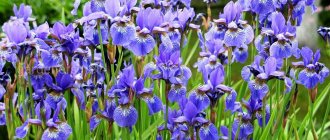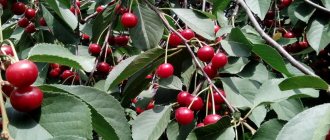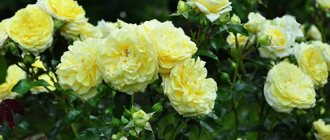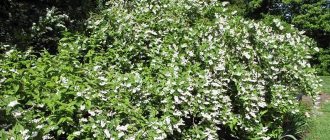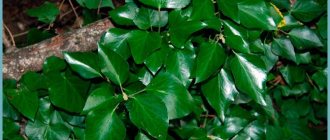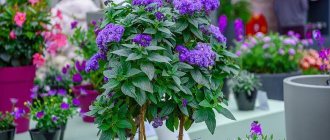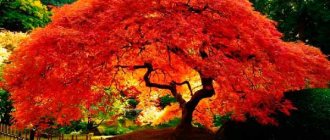Cherries and cherries are fruit crops of the same family. The accidental successful cross-pollination of cherries and cherries gave rise to a new type of fruit crop, which was popularly called cherry, cherry-cherry and other difficult-to-pronounce names. Our love for abbreviations did not fail this time either. From the name of the English variety of cherry, bred in England in the 17th century, and called the May Duke (May-Duke), the shortened name Duke was established in Russia, which means “Duke”. Gardeners liked the culture, especially because the plants became more resistant to negative temperatures and certain fungal diseases.
Hybrid of cherries and sweet cherries, Duke variety Pivonya
Beginning in 1926, the Dukes began to explore the space of the USSR. And by the beginning of the 90s of the 20th century, more than 30 varieties and hybrids were added to the catalogs of Dukes, advanced far beyond the Central Black Earth regions.
Duke features
Hybrids of cherries and sweet cherries differ in many ways from their “parents”:
- Unlike parental pairs, dukes are self-sterile. “Loneliness” is contraindicated for them. In order for the hybrids to bear fruit, zoned varieties of cherries and sweet cherries, the so-called pollinators, are planted nearby.
- Dukes themselves are ineffective as pollinators.
- In the middle zone and in the Central Black Earth region, self-fertile cherries - Lyubskaya, Bulatnikovskaya, Molodezhnaya - are usually used to pollinate dukes.
- The best pollinator of dukes is the cherry. Recommended pollinators for cherry trees are Donchanka, Priusadnaya, and Annushka cherries. And the Iput cherry is considered an ideal variety for pollination.
You can read about the listed varieties of cherries in the following article.
- When purchasing duka seedlings, you also acquire a pollinator. A high-quality pollinator is able to pollinate more than a third of the flowers - this is enough for the tree to be covered with fruits.
- Dukes, compared to cherries, are more winter-hardy. On the contrary, cherries are inferior in winter hardiness. Because of this, in the northern regions they grow in the form of bushes - gardeners cover them for the winter, saving them from extremely low temperatures.
- Dukes are not fed throughout their lives. Due to an excess of nutrients, the tree begins to develop intensively, which, spending energy on growth, does not have time to really get stronger and prepare for winter. This leads to the absence of fruits or the death of the plant.
The second name for cherry is duk. In the 17th century, a hybrid of cherries and sweet cherries was developed in England; it was named “May-Duke,” which literally means “Duke of May.”
Secrets of growing a hybrid crop
In order for Duke cherry to appear on your summer cottage, first of all, you need to plant it correctly. There are a few simple rules without which it is impossible to achieve success. Let's look at each of them in detail.
Purchasing a seedling
High-quality trees are sold in specialized retail outlets. Important information is included with the offered copies:
- Duke variety;
- ripening period;
- degree of frost resistance;
- seedling age.
The most suitable are one- or two-year-old trees. They quickly take root in the new area. It is good if the root system consists of a strong central and several lateral roots. A seedling with mature wood with uniform coloring without visible damage is suitable. Its height should be approximately 60 cm.
Duke cherry is planted in the spring in the northern regions, and in the autumn in the southern regions.
Choosing a comfortable area
Hybrids prefer soil with neutral acidity. If necessary, liming of the soil is carried out. Agronomists do not recommend planting cherry trees in valleys where water stagnates. Otherwise, the tree will get sick and die over time.
The best place for Duke is an open sunny area. However, there should be no drafts on it. The distance from neighboring crops is at least five meters. The site begins to be prepared 15 days before planting the cherry trees. First, it is carefully dug up with a shovel. Then they mark and dig a hole.
Funnel preparation
If the hybrid is planned to be planted in the spring, a suitable hole is dug in the fall. Its width is about 60-70 cm, and its depth is 50-70 cm.
Next, prepare a nutrient substrate from the following components:
- humus (about 3 kg);
- wood ash (200 g);
- superphosphate (50 g);
- potassium sulfate (40 g);
- garden soil.
Fertilizers are thoroughly mixed with the soil. The resulting mixture fills the hole to approximately 75% of the total volume.
Planting Cherry Duke
2-3 days before the start of the process, the root system of the seedling is dipped in a manganese solution to destroy pathogenic microbes and fungi. It is also kept in special growth stimulants. Most often they use “Kornevin” or “Zircon”.
A stake is driven into the prepared funnel, which will provide reliable support for the seedling. The tree is then placed in the hole. The roots are straightened and then covered with soil. The root collar should protrude slightly above the ground. After planting, pour 2 buckets of warm water onto the root area.
Watering rules
Young seedlings are moistened every week to stimulate the successful development of the hybrid. Mature crops are watered less frequently. During the dry season, approximately 40 liters of water are used to irrigate the crop. However, cherry trees do not like excessive dampness. It leads to rotting of the root system, cracking of the upper cover of the trunk and branches.
Trimming
The first time the procedure is carried out immediately after planting the crop. From the base to the top of the seedling there should be no more than 60 cm. Therefore, the excess part of the branches is removed. The second pruning is done after 2 years. The side branches are shortened by 1/3 of the length. After wintering, damaged elements are removed, thinned out and the crown is formed. Mature trees that are older than 5 years undergo anti-aging pruning.
We got acquainted with the external features of cherry trees, planting, care and pruning of the crop. We looked at photos of popular species that are suitable for the Moscow region. We “tasted” the sweet and sour berries of the hybrid. Now we can confidently begin growing a unique variety in our summer cottage.
Description and characteristics
The cherry tree is small, the crown is compact. The branches, arranged symmetrically, are covered with elongated glossy leaves. The inflorescences are white and the fruits are red-cherry.
Duke, being an intermediate crop, combines the characteristics of two plants at once:
- Fruit. In appearance and taste of the fruit, duki are closer to cherries, but in size and sugar content they are similar to cherries.
- Leaves. Large, like cherries. Density, color and shine - like cherry.
Cherry characteristics:
- The average weight of berries is 8-10 g.
- The taste is sweet, with slight sourness.
- The first fruits appear in the 3rd year after planting.
- The average yield is 10-15 kg per tree per season.
External characteristics of dukes
Dukes belong to stone fruit crops and are cherry-cherry hybrids. If we compare dukes with their parents, then the “children”, taking an intermediate place, took all the best from the parent pairs, but still the vast majority of varieties turned out to be self-sterile. Because of the beauty of their abundant but empty flowering, dukes in the country are often used as an excellent ornamental crop.
The self-sterility of a hybrid crop is associated with exposure to weather conditions. Sudden temperature changes, both unexpected frosts and extreme heat, negatively affect the physiological processes in the plant responsible for the formation of pollen and eggs. The number of normally developed duka flowers capable of pollination can decrease to 1%, sometimes sexually mature flowers are not formed at all. With normal development of only 3-5% of flowers, the crop is literally hung with tasty large fruits with delicate pulp of different shades.
Cherry-cherry hybrids in the south and in regions with mild winters form powerful trees with a wide spreading crown. Breeders have obtained varieties of dukas that bear fruit freely in the cold regions of the North and Siberia, but there it is more practical to grow them in a bush-like form.
The hybrids themselves are more similar to cherries in appearance and quality of the fruit. In terms of the density of the leaf blades and their size, the leaves are more reminiscent of cherry leaves. The leaves are long-petiolate, the arrangement on the shoots is alternate. The color is rich green.
The central trunk of dukes and perennial shoots are smooth (cherry-like), the color of the bark is dark brown. Sometimes skeletal shoots are located at an acute angle to the central trunk.
Depending on the region and climatic conditions, flowering can be early or late. For example, in central Russia, dukes bloom in the last ten days of June, in the south - in May. The flowers are white or slightly pink, collected in bouquet-like inflorescences, which are located on annual growths.
Dukes belong to early-bearing crops and, when good pollinators are selected, already in the third year they form the first (test) fruit crop. At the end of flowering, unpollinated flowers fall off. Formed fruits, on the contrary, remain on the branches for a long time and even improve their taste.
Dyukov fruits are extremely tasty. Imagine a large cherry, whose dense, sweetish-herbaceous pulp has become more tender and acquired an ennobling cherry aroma with a pleasant, refreshing aftertaste.
Advantages and disadvantages of a hybrid
Each of the parent trees - cherry and sweet cherry - are good in their own way, but their hybrid also has enough advantages. Cherry benefits:
- Disease resistance. They are immune to moniliosis and coccomycosis - diseases due to which many cherry orchards have no harvest for years. There are dukes that are almost not affected by the cherry fly.
- High taste characteristics. The fruits of duki have a wonderful taste - a unique cherry flavor combines favorably with cherry sweetness.
- Large fruit. The maximum fruit weight reaches 15-20 g.
- Frost resistance. The tree withstands frosts down to 24-26 °C
- Low maintenance requirements. Virtually no need for feeding. The amount of watering becomes minimal with age.
Cons of cherry:
- The buds do not withstand frost well enough and are prone to freezing.
- Poor transportability.
- Needs regular pruning as it is prone to overgrowth.
A FEW WORDS ABOUT VARIETIES
I can only talk about those varieties that grow on my site. All of them were bred by L.I. Taranenko and A.I. Sychovy and belong to the latest generation varieties.
Spartan
. Medium ripening variety. Its most valuable quality is the high winter hardiness of the tree itself and flower buds. The fruits are very tasty, large (weighing 7-9 g), dark-colored, with juicy sweet pulp and a pleasant cherry aroma. They ripen in early July, but have a thin skin and are poorly transportable, so the berries are suitable for fresh consumption or quick processing. But the variety is exceptionally resistant to adverse weather conditions, which is why it got its name. In addition, it is weakly affected by coccomycosis and moniliosis.
Hodosa
. The variety is mid-early, ripening occurs in late June - early July. The tree is not very tall and has a spherical crown. The fruits are large (up to 8-9 g), dark cherry, the flesh is dark red, sweet with a slight sourness. The variety is very productive. The tree and flower buds have increased winter hardiness and drought resistance. Resistant to diseases. The skin on the fruit is quite dense, so the berries have increased transportability.
Ivanovna
. Refers to later varieties. Fruiting begins in mid-July. The shortest and most compact tree with a dense spherical crown, but very productive. The fruits are cherry-colored, with reddish pulp, very juicy, large (8-9 g). The taste is more reminiscent of cherries, although sweet, but more sour than other varieties. Winter hardiness is one of the highest among new dukes. The variety begins to bear fruit earlier than others (in the 4th-5th year). Resistant to coccomycosis and moniliosis.
Related link: Winter-hardy cherry varieties for cold regions (photo + description)
Strong
. The variety is very early, one of the first to ripen. It got its name from the dense pulp and thick skin of the fruit. The tree is tall, with a rounded crown. One of the most productive varieties. The fruits are very tasty, dark red with dark pulp, sweet, more reminiscent of cherries, although they have a light cherry aroma. It has high winter hardiness of the tree and flower buds. Ripe fruits can hang on the tree for up to two weeks without overripening or falling off. Therefore, they tolerate transportation well.
Miracle cherry . This is one of the earliest varieties of Dukes. In appearance, the tree is more like a cherry tree, it is of medium height, spreading, fruiting is very abundant, like a cherry tree - mainly on bouquet branches. The fruits are very large, weighing 9-10 g, dark red, medium density, sweet cherry flavor with a pleasant acidity. Ripens at the end of June along with early cherry varieties. Winter hardiness is average, resistant to fungal diseases.
I read a lot about the newest varieties of dukes, mainly selected by A.I. Sychova. Experts rate varieties such as Kormilitsa, Alisa, Nochka
, and a number of others. All of them have the highest economic qualities, and most importantly - increased winter hardiness.
© Author: O. IVANOVA Moscow region
ORDER QUALITY AND CHEAP SEEDS AND OTHER GOODS FOR YOUR HOME AND GARDEN. PRICES ARE PRICEY. CHECKED! JUST LOOK FOR YOURSELF AND BE SURPRISED. THERE ARE REVIEWS. GO>>>
Below are other entries on the topic “Do-it-yourself cottage and garden”
- Which cherry varieties turned out to be resistant to frost and disease this year - test: Frost-resistant cherry varieties + resistance...
- Cherries and sweet cherries in Siberia - expert reviews of the best varieties: SIBERIAN CHERRY AND CHERRY What we...
- New varieties of cherries and sweet cherries - photos, name and description, expert reviews: NEW VARIETIES OF CHERRY AND CHERRY...
- Planting felt cherries - tips: How best to plant felt cherries
About... - The best varieties of cherries - name and description (Penza region): MY REVIEWS ABOUT CHERRY VARIETIES...
- Winter-hardy, frost-resistant cherries - varieties: We choose the most winter-hardy varieties of cherries...
- Unusual hybrids for the garden bred by crossing: Hybrids for the orchard and…
Subscribe to updates in our groups and share.
Optimal growing regions
Since breeders have developed dozens of winter-hardy cherry varieties, they have been grown in almost all regions of Russia. When choosing a variety for planting, it is important to correlate its frost resistance - the lowest possible temperature withstandable - with the winter temperatures characteristic of a particular region. Depending on climatic conditions, the appearance of the plant is formed - in the form of a tree or in the form of a bush.
The first cherry trees did not feel comfortable even in the middle zone, but today’s varieties are hardy and frost-resistant, and have moved far to the north. Today, dukes grow and bear fruit in the Leningrad, Nizhny Novgorod, Novosibirsk regions, Siberia, and the Far East.
What varieties of cherry are there?
The first cherry variety, “Beauty of the North,” was bred by I. Michurin. The hybrid had excellent winter hardiness. It has large—up to 10 g—soft scarlet berries with creamy yellow flesh. After Michurin, other breeders continued to work on developing winter-hardy cherry varieties.
Petrov Alexander Yuryevich Agronomist, chief technologist of the Aleksandrovskaya Dubrovka nursery Today there are dozens of duka varieties on the market, differing in ripening time, berry size and frost resistance. Their yield is approximately the same - 10-15 kg per tree, and it depends mainly on the growing conditions.
Let's look at the features of popular types of dukes in the table below. Table 1
Landing
The main features of proper planting of cherry seedlings are maintaining intervals between neighboring plants and preparing the pit. All other agrotechnical measures are the same as for other fruit trees.
Selecting a location
When creating plantings of dukes, cherries and cherries, it is recommended to select a site that meets the following requirements:
- Sunlight all day long. There should be no shadow, but partial shade is allowed.
- The soil must be nutritious. Wetlands are excluded.
- Elevation is preferable; the groundwater table should not be higher than 2 m.
- Protection from drafts and winds.
- There should be cherry and/or sweet cherry trees nearby for pollination.
- The minimum distance to neighboring crops is 5 m.
Dukes are not planted in lowlands. In winter, cold masses are concentrated here, and in summer the humidity is too high. The best option for dukes is areas with sandy loam soils and indirect, diffused light.
Acidic soils are neutralized with chalk - add 1.5 kg per 1 sq. m. m. Heavy clay soils are replaced during planting with fertile soil and sand mixed in equal parts.
When preparing the soil for planting, you should maintain fertilizer standards for dukes - they do not like soils that are too nutritious.
Purchase and preparation of seedlings
Cherry seedlings are prepared for planting in the same way as any other planting material for fruit trees. The seedlings are soaked in water a day before planting, and then all damaged roots are cut off with pruning shears.
When buying duke seedlings, pay attention to:
- age and time of landing;
- variety;
- pollinators.
Seedlings aged 2-3 years are considered to have the best survival rate. Other recommendations for choosing planting material:
- the presence of a tag indicating the age of the seedling, variety, pollinator varieties and other details of agricultural technology;
- trunk – straight;
- the root system is developed, without signs of disease;
- shoots are colored evenly, without gum or damage;
- the height of the main trunk is about 60 cm, the branches are shortened by a third - such signs indicate properly prepared planting material;
- the variety must be regionalized and suitable for specific climatic conditions.
The health of the roots of seedlings is indicated by the white color of their cuts.
Duke seedlings should be purchased from nurseries or specialized farms that professionally grow fruit trees.
Landing in the ground
It is better to plant dukes in early spring, when the soil has warmed up to the desired temperature. If you plant seedlings in the fall, they may die without taking root. Autumn planting is only suitable for regions with warm climates.
Features of planting duka seedlings:
- The pit is prepared a month before planting.
- The distance between adjacent holes is 4-5 m if 2 or more cherry seedlings are planted. This is enough so that the trees, when they become adults, do not interfere with each other.
- The dimensions of the hole must be such that the root system fits freely in it.
- Drainage must be laid at the bottom of the hole to prevent stagnation of water near the root system. Make a drainage layer from stones or broken bricks.
- A manure-soil mixture is poured onto the drainage. The mixture includes a fertile layer.
- The soil obtained by digging a hole is mixed with superphosphate (300-400 g), potassium sulfate (250-300 g) and ash (2-3 cups).
- If planting is done in infertile, depleted soil, compost or humus is added to the hole - one bucket.
- The seedling is placed in a hole, its roots are straightened. Sprinkle with soil so that the root collar and the surface of the earth are at the same level. You should not bury the seedling too much - rot may develop, which will lead to the death of the young tree.
- When the seedling is planted, water is poured under the root - 2 buckets.
What is prepared from cherries?
Cherry cherry is suitable for dessert snacks and drinks. There are many interesting recipes.
Jam
For a kilogram of berries take:
1.2 kg of sugar and a glass of water.
How to cook:
Prepare syrup from water and sugar. Rinse the berries. Remove the seeds. Pour syrup into berries. Wait until it boils and remove from heat. The jam should brew. When it has cooled, it is placed back on the fire and brought to a boil again. The procedure must be repeated several times. Then the jam is put into clean jars.
Liquor
What you need to take:
3 cups of berries, ½ cup of water, 3 tablespoons of powdered sugar, ½ cup of sugar, 500 ml of cognac, a glass of vodka, nutmeg.
How to cook:
Wash the cherry, pierce it to release the juice, and sprinkle with powdered sugar. When the powder melts, pour in vodka and cognac. Shake well. Leave to infuse for 1.5 months. Then squeeze the berries and strain the liqueur. Boil syrup using water and sugar. Mix the cooled syrup with liqueur, add nutmeg. Store the finished liqueur in sealed bottles.
Cherry care
Caring for hybrids of cherries and sweet cherries does not cause difficulties even for novice gardeners. By devoting a minimum of time to this unpretentious tree, you get large harvests of delicious berries. Unlike other fruit trees, dukes do not need fertilizing, which makes care even easier.
Regularity of watering
It is recommended to water the planted young plants every week. Water abundantly, use settled water, not cold. The older the tree gets, the less frequent the watering. Watering for dukes is a must, regardless of age. An adult tree requires approximately 20-40 liters of water. During periods of prolonged drought, the displacement is increased.
Like all stone fruits, cherry trees do not like frequent and abundant irrigation. Overmoistening leads to rotting of the roots and cracking of the trunk bark and skeletal branches. Trees need more watering until they are 5 years old, and then the frequency of irrigation is reduced based on the weather.
The need for digging and mulching
To make the root system feel comfortable, two loosenings per season are enough. Loosening saturates the soil with oxygen and at the same time removes weeds. It is recommended to loosen the soil in tree trunk circles after watering. Gardeners often sow green manure in gardens to fertilize the soil; for dukes, this option is allowed, but with one condition - the tree trunk circle should only be under black fallow.
To prevent the tree roots from overheating and moisture from the soil from evaporating too quickly, the tree trunk circle is mulched. Recommended mulch is hay. Do not spread mulch on dry soil.
Top dressing
The absence of the need for feeding is an important advantage of dukes. Fertilizers are applied only when planting a seedling. In the future, the gardener is spared from fertilizing - the dukes develop better and bear fruit in soils of average nutritional value.
Pruning and crown formation
The first time cherry trees are pruned immediately after planting. From the surface of the ground to the pruning point - 0.6 m. Having trimmed the top, cut off the skeletal branches. On seedlings 2 years old, the side branches are cut by 1/3.
While there is no harvest, the young animals are growing intensively. And as soon as the first berries appear, growth activity decreases. The crowns are thinned out in a timely manner - their thickening leads to a decrease in yield. When cutting branches, take into account the angle at which they depart from the trunk - the sharper it is, the smaller the end to be cut off.
For old trees, rejuvenating pruning is carried out every 5 years - sprouts are removed from the entire crown - to the level of four-year-old trees.
How to grow a Miracle cherry tree?
In order for such a plant to really bear a lot of fruit, it is necessary to provide it with proper care. It consists of spring pruning, fertilizing, watering, thoroughly clearing the area of weeds and various garden debris.
When to plant trees?
The Duke Miracle cherry variety, although considered a fairly frost-resistant plant, is still not suitable for the northern regions. It feels great in mid-latitudes, so here it provides quite a large yield. The optimal time for planting is the second half of April. During this period, the threat of frost has already passed, and the seedlings will be as ready as possible for adaptation to the new site.
Keep in mind that for optimal development of crops, you will need good soil heating, as well as a temperature greater than +10 degrees. Plants become dormant only when the indicators drop below.
In the southern regions, you can even plant trees at the end of March. It is also practiced to plant in the autumn, preferably in the second half of September, a month before the cold weather sets in.
Landing area
The Duke Miracle cherry variety prefers flat and open areas with a fairly large amount of ultraviolet rays. If there are slopes on the territory, then it is better that they are gentle. If the area is too shaded, the quality of the berries will deteriorate.
In the middle climatic zone, seedlings of Duke Miracle Cherry plants are located in areas with a southeast or southwest direction. If the area is windy, then it is better to protect the crops by planting them near buildings or a fence.
It is strictly not recommended to place seedlings in low-lying areas where there is standing water and humid air flow. This is detrimental to crops. Planting in areas with high groundwater is also considered detrimental to the plant. Optimal soils for planting crops are considered to be chernozems, forest and brown soils, loamy and sandy loam compositions. In clayey, heavy soils you will need to add a little sand, compost, peat or rotted straw.
Preparation and planting of seedlings
If you do not have self-grown seedlings, you will need to purchase them. It is better to give preference to proven nurseries. Buy annuals with several shoots, a well-developed root system and mature wood.
The procedure for planting crops can be divided into several stages:
- First, mark the area. There should be at least 3-4 meters between adult representatives, and less than 5 meters between rows.
- After marking the area, you should move on to the planting holes. Their parameters are 80 by 80 centimeters, but can be increased by 10 cm. The depth of the hole is up to 50 centimeters. By visually inspecting the rhizome, you can determine the parameters of the planting pit. It is extremely important to dip the plants in a solution of Zykron or Kornevin a couple of days before planting to stimulate the root system.
- We mix mineral and organic components before planting (3 buckets of manure, wood ash (1 kg), superphosphate (100 g) and potassium sulfate (80 g). Place the fertilizer on the bottom of the hole. Also pour out a bucket of water.
- A support for the future tree is driven into the center of the hole, the diameter is up to 7 centimeters, the length is up to 1.5 meters. A mound of soil mixture is poured around the support. The seedling itself is cleaned of broken roots that are rotten.
- Then the seedling is immersed in the bottom of the hole, it is fixed to a support in order to place the root collar on the mound from below. Then the rhizomes are gradually covered with soil. After 15 cm of soil, a bucket of water is poured, and then soil is added again.
- Using soft braid, the planted tree is attached to the support.
Since all varieties of dukes cannot do without pollinating trees, ordinary cherries and sweet cherries are planted next to the hybrids. In this case, the flowering dates are chosen late, and for cherries – early. The most suitable pollinators are the Molodezhnye, Lyubskie, and Bulatnikovskie cherries. Suitable cherries are “Yaroslavna”, “Iput”, “Lyubskaya”.
Basic secrets of caring for the Duke miracle cherry hybrid
Watering garden crops is an integral part of obtaining beautiful and healthy plants. It is not recommended to water duki at the root, so as not to expose the root system and provoke various crop diseases. To make irrigation easier, 2 furrows are made along the projection of the crown to a depth of 20 centimeters. The first hole is made half a meter from the trunk, and the second is another half a meter further, but already from the first.
Such crops respond better to a lack of watering than to an excess of water. Excess water is a signal for disruption of natural aeration. If precipitation falls regularly, then additional watering will be needed only 3 times throughout the growing season:
- immediately after flowering;
- during the ripening period of sweet cherries;
- at the end of October after the leaves have fallen.
Under one tree you will need to add 3-6 buckets of liquid. Young crops are watered 2 times a week for 20 days after planting. Afterwards, irrigation is reduced to once every 14 days. For 1 plant, 2 buckets of water are enough. When the liquid is completely absorbed, mulching is carried out. Peat, dried grass or compost are suitable for such purposes.
In order not to harm the plants, they are watered only in the evening, after the sun has hidden. You will also need to periodically loosen the soil in the tree trunk circle to remove weeds.
Diseases and pests
Among the fungal diseases that threaten dukes, the most dangerous and common ones are shown in Table 2.
table 2
| Pests and diseases | Symptoms of the lesion | Control measures |
| Fruit rot | The fruits have characteristic putrefactive spots. It develops when the integrity of the surface of the berries is damaged - for example, after a hailstorm or due to pest damage. | Spray with fungicides 1-4 times for 7-10 days. For example, Topaz, Previkur, Skor and others. Or they use folk remedies - ash, soda, garlic infusion, etc. |
| Powdery mildew | A white coating appears on the leaves - they become deformed, change color, and then fall off. | Prevents fruit damage. Perform preventive spraying with Fitosporin-M. An iodine solution also helps - 10 ml per 10 liters of water. Spray the entire tree, repeating the procedure after 3 days. |
| leaf roller | Chewed and curled leaves. | They are treated with biological insecticides (Bitoxibacillin, Lepidotsid) or chemicals (Ditox, Karbofos, Fufanon). |
| cherry fly | Larvae develop in the fruits and eat the pulp. | Treatment with universal chemicals (Sigmaen, Fufanon and others) or folk remedies. They are repelled by herbal plants, sprayed with fragrant infusions, and caught with sticky traps. |
Preparing for winter
Modern varieties of dukes are quite frost-resistant, so they do not require insulation for the winter - mulching the tree trunk circle is enough. Hay or fallen leaves are used as mulch. Varieties that are not particularly resistant to frost, grown in regions with harsh winters, are better insulated. Seedlings that have not reached 5 years of age are insulated for the winter, regardless of the growing region.
Insulation of dukes:
- the crown is covered with thick and dense polyethylene;
- The tree trunk is covered with snow.
Many gardeners wrap the trunks of fruit trees, including dukes, with burlap. Or covered with spruce branches. This method of shelter allows you to solve two problems - to save the tree from frost and from rodents. Hares are a terrible danger to young trees, and the smell of pine needles effectively repels them.
Harvest and storage
Cherry fruits are ready for harvest in June or July - it all depends on the climatic characteristics of the region and the ripening time of a particular variety. The harsher the climate of the region, the later the harvest.
The berries are removed without tearing them off the stalks - this extends the shelf life and allows the harvest to be transported. The transportability of dukes is unimportant; it is not recommended to store the berries - it is advisable to put them into processing as soon as possible.
If you can’t immediately process the fruits, you can extend their life by placing them in the refrigerator. There is no need to wash them before storing them. containers are not covered. Cherry berries are stored for no longer than two weeks. The berries are used to make candied fruits, marshmallows, jam, and liqueurs. The fruits can also be dried and frozen.
Division of varieties by ripening groups
The newest duka cultivars can be grouped into five distinct categories, characterized by different periods of ripeness.
- The first group includes cultivars that ripen early. This is Pren Corai, our Miracle Cherry and also our Strong variety, they already produce a harvest ready for harvest in mid-June.
- Group two (the fruits ripen in about a week) includes the following varieties: Saratovskaya Malyshka, Daughter of Yaroslavna and Melitopolskaya Radost.
- The third category includes those that ripen around the end of June, these are Fesannaya, Nurse, Spartanka and Hodosa.
- Group four (the fruits of these varieties ripen at the very beginning of July) are Ivanovna, Dorodnaya, Pivoni and Donetsk Velikan.
- The fruits of the fifth group of dukes ripen later than others, approximately in the middle or even the third ten days of July. These are Nochka, Excellent Venyaminova and Shpanka Donetskaya (not to be confused with Shpanka Bryanskaya - this is an ordinary cherry).
Continued in the article How to grow dukes?
Photo by the author
Reviews from gardeners
When deciding whether to plant cherry cherries in the garden or not, and if so, what variety, it is important to read reviews - about hybrids in general, and then about varieties separately.
★★★★★
Nikolay Elnikov, Kursk region. The Miracle Cherry variety grows in my garden.
Its berries ripen very early, the tree practically does not suffer from anything - the simplest preventive measures help. The ubiquitous cherry fly is not particularly interested in my duke. I harvest 12-15 kg. The disadvantages are the presence of a pollinator and the need to form a crown. The tree was planted 8 years ago. The berries are much sweeter than cherries, the sourness is barely noticeable. The taste is such that you won’t immediately understand what it tastes more like – cherry or sweet cherry. ★★★★★
Lyudmila L., Murom. I planted a seedling of the Excellent Venyaminova variety.
Perhaps it was necessary to choose a more frost-resistant variety. The berries were very tasty, and they appeared two years after planting. Each harvest was larger than the last. But our winters are cold, even though we covered the tree for the winter, in the eighth year it still froze and never recovered. Hide
Add your review
Duke is a great opportunity to experiment and add variety to your garden. Thanks to new frost-resistant varieties, dukes are confidently moving north, becoming available to gardeners from regions with harsh climates. This unpretentious and hardy hybrid with abundant harvests is a desirable trophy for any garden.
0
0
Copy link
Duke propagation: the most common methods
Every gardener is always concerned with the question of how you can independently obtain many seedlings of a hybrid of sweet cherries and cherries or dukes at home. Like many other varieties of the same cherry, Duke can be propagated by several vegetative methods, including propagation by cuttings, layering and grafting. Generative or seed propagation of such a hybrid is not advisable, since the result will be a completely different variety.
Duke propagation by cuttings
- The best time to propagate duke using cuttings is the end of August or the beginning of September. This is important, since in this case lignified cuttings are used and the temperature outside is still quite warm. However, it is important to consider that such cultivation of duke is accompanied by minor difficulties. To avoid them, you need to regularly care for planting material.
- First of all, it is necessary to prepare planting material. It is best to harvest cuttings for planting from the lower branches. Be sure to treat all cuts with charcoal.
- The cuttings should be placed in a container with a growth stimulator for several hours.
- Next, in the open ground, prepare a bed, dig it up and fertilize it with organic matter.
- Root the cuttings and cover the top with film or cover each seedling separately with a bottle or jar.
- Plantings need to be watered, fed and fertilized regularly.
- If you follow all the rules of care, the cuttings will take root before the onset of cold weather, so they can be hilled up and well covered so that the duke seedlings can survive the winter.
Duke propagation by grafting
- This propagation method is used to obtain higher quality and more productive duka trees.
- First of all, you need to select suitable rootstocks, which can be strong and frost-resistant varieties of cherries or sweet cherries.
- Duke varieties are best planted in the spring around April, when the period of sap flow begins.
- To propagate dukes in the spring, it is best to use bud grafting - this is the easiest and simplest method.
- You need to take a green cutting and carefully cut off a healthy bud with a shield, the length of which should be approximately 30 cm.
- Next, the bark of the rootstock is cut to the same length, after which it is cut off, leaving only 10 cm.
- The cutting is applied to the bark and tightly wrapped with a plaster or tape so that the bud is at the top.
- To speed up the grafting of the cutting, you can cover the junction with film, thereby creating a mini-greenhouse.
